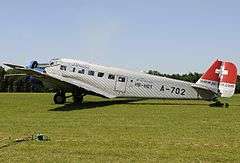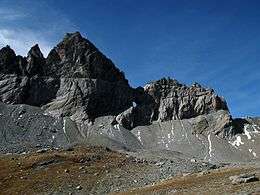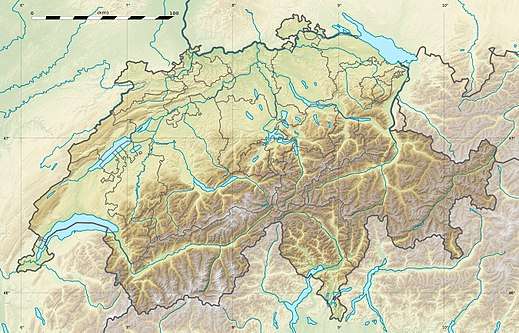2018 Ju-Air Junkers Ju 52 crash
 HB-HOT, the Ju 52 involved in the accident, photographed in 2009 | |
| Accident | |
|---|---|
| Date | 4 August 2018 |
| Summary | Under investigation |
| Site |
Piz Segnas mountain, Glarus Alps, Switzerland 46°53′53″N 09°13′40″E / 46.89806°N 9.22778°ECoordinates: 46°53′53″N 09°13′40″E / 46.89806°N 9.22778°E |
| Aircraft | |
| Aircraft type | Junkers Ju 52/3mg4e |
| Operator | Ju-Air |
| Registration | HB-HOT |
| Flight origin | Locarno Airport |
| Destination | Dübendorf Air Base |
| Occupants | 20 |
| Passengers | 17 |
| Crew | 3 |
| Fatalities | 20 |
| Survivors | 0 |
On 4 August 2018, a Junkers Ju 52 passenger aircraft operated by Ju-Air crashed near Piz Segnas, Switzerland, while en route from Locarno to Dübendorf. All 20 people on board were killed.
It was the first fatal crash of a Ju-Air aircraft since the company began operations in 1982. The cause of the crash is under investigation.
Aircraft and crew
The aircraft involved was a tri-motor Junkers Ju 52/3mg4e, registration HB-HOT, msn 6595. It had served with the Swiss Air Force from 1939 to 1985, when it was acquired by Ju-Air, a company that offers sightseeing flights on vintage aircraft, and had logged 10,000 hours of flight time.[1] It had been used in the films Where Eagles Dare (1968) and Valkyrie (2008).[2] The aircraft had been issued with a certificate of airworthiness by the Federal Office of Civil Aviation on 6 April 2018, valid for two years.[3]
On the day of the crash, the Junkers was piloted by two veteran captains, aged 62 and 63. Both had extensive experience as pilots for Swissair, Swiss and Edelweiss, as well as more than 30 years of militia service with the Swiss Air Force. Both also had several hundred flight hours' worth of experience with the Ju-52.[4] The third crew member was a 66-year-old flight attendant, also with 40 years of professional experience.[4]
Accident
The aircraft was flying from Locarno Airport to Dübendorf Air Base, on the return leg of a two-day trip. The weather was unseasonably warm with choppy winds.[5] At 16:56 local time on 4 August (14:56 UTC),[3] the Junkers crashed into Piz Segnas mountain, at an elevation of 2,540 metres (8,330 ft).[1][6]

Swiss authorities said at a press conference on 5 August that the plane appeared to have crashed almost vertically and at high speed. A witness at nearby Segnas Pass saw the Junkers approaching from the south and fly by the Martinsloch, a distinctive 18-metre-wide (60 ft) breakthrough, or hole, in the Tschingelhörner mountain ridge, next to the pass. Then, instead of flying over the ridge, the aircraft made a sharp turn, dived vertically and crashed onto the plateau below.[7] Around 10 minutes before the crash, another witness had observed the Ju 52 suddenly banking sharply to the left and descending, before increasing engine power and recovering to normal flight.[3]
The aircraft was carrying three crew and seventeen passengers,[3] all of them Swiss apart from an Austrian couple and their son.[8] Nine of the people aboard were women and eleven were men.[9] Swiss authorities confirmed that there were no survivors.[10][11]
In response to the accident, Ju-Air suspended all flights by its other Ju 52 aircraft,[12] until they resumed operations on 17 August under more strict conditions.[13][14]
Investigation
The accident is being investigated jointly by the Swiss Transportation Safety Investigation Board (STSB) and the cantonal police of Grisons on behalf of the federal and cantonal prosecutors' offices.[2] Hiking routes and the local airspace were closed off to allow for a large-scale salvage operation, involving five helicopters, which aimed to secure the wreckage in the difficult-to-access terrain.[4]
A spokesperson for the STSB said that the Junkers "fell like a stone to the ground",[15] and that the heatwave in Europe could have been a factor in the crash, as heat reduces an aircraft's climb performance.[16] The police indicated that no distress signal was received from the aircraft prior to the crash.[8] Investigators ruled out a collision with a cable or another aircraft, and said that there was no indication of foul play or the aircraft losing parts before the crash.[4] The aircraft was not fitted with any flight recorders.[9] Investigators are hoping to find some relevant information from passengers' personal photographic and video recordings during the sightseeing flight.[17] The STSB issued its preliminary report on 15 August 2018.[18]
See also
References
- 1 2 "HB-HOT Accident description". Aviation Safety Network. Retrieved 5 August 2018.
- 1 2 "Bis zu 20 Todesopfer befürchtet" [Up to 20 fatalities feared] (in German). 20-Minuten. 4 August 2018. Retrieved 5 August 2018.
- 1 2 3 4 Hradecky, Simon (4 August 2018). "Crash: Ju-Air JU52 at Piz Segnas on Aug 4th 2018, impacted terrain". The Aviation Herald. Retrieved 5 August 2018.
- 1 2 3 4 "Vintage aircraft crash kills 20 people". Swissinfo. 6 August 2018. Retrieved 9 August 2018.
- ↑ Die Wetterstation liegt in etwa 2500 m Höhe am Crap Masegn.
- ↑ Vorbericht der Schweizerischen Sicherheitsuntersuchungsstelle SUST
- ↑ Fröhlich, Cedric (6 August 2018). "-Hüttenwart sah Absturz: "Es hat keine 15 Sekunden gedauert"". Der Bund. Retrieved 6 August 2018.
Sie fliegt Richtung Norden. Am Martinsloch vorbei. Anstatt über den Grat zu fliegen, geht das Flugzeug in eine scharfe Kurve. Felder rennt nach draussen. Die Ju-52 kippt unvermittelt in den Sturzflug. Ein dumpfer Einschlag. Das Flugzeug prallt senkrecht auf dem Hochplateau unter dem Martinsloch auf. «Als hätte man ein Lot aufgestellt», sagt Feldner. Anflug, Kurve, Absturz. «Es hat keine 15 Sekunden gedauert.»
- 1 2 "Vintage plane crashes in Swiss Alps, killing all 20 on board". USA Today. Associated Press. 5 August 2018. Retrieved 5 August 2018.
- 1 2 "Vingt morts dans l'accident d'un avion militaire de collection suisse" [Twenty dead in the crash of a Swiss military aircraft] (in French). La Croix. Retrieved 5 August 2018.
- ↑ "Flugzeug mit 20 Personen beim Piz Segnas abgestürzt" [Plane with 20 people crashed at Piz Segnas] (in German). Blick. 4 August 2018. Retrieved 5 August 2018.
- ↑ Hughes Neghaiwi, Brenna (4 August 2018). "Second plane crashes in Swiss Alps on Saturday". Reuters. Retrieved 5 August 2018.
- ↑ "Switzerland crash: Twenty dead in WW2 plane crash". BBC News. 5 August 2018. Retrieved 5 August 2018.
- ↑ Neghaiwi, Brenna Hughes. "Swiss airline to resume flights two weeks after deadly crash". U.S. Retrieved 2018-08-08.
- ↑ "Swiss vintage planes resume flights after crash". Retrieved 21 August 2018.
- ↑ "'Sie ist wie ein Stein zu Boden gestürzt'" ['It fell like a stone to the ground'] (in German). Spiegel. 5 August 2018. Retrieved 5 August 2018.
- ↑ "Heat wave could be behind Swiss crash of vintage plane that killed 20 in the Alps". KIRO7 Seattle. Retrieved 6 August 2018.
- ↑ "Ju 52 Crash: Mögliche Videos der Passagiere als "Blackbox-Ersatz"" [Ju 52 crash: possible videos of passengers as a "black box replacement"]. Austrian Wings (in German). 9 August 2018. Retrieved 9 August 2018.
- ↑ "(untitled)" (PDF) (in German). Schweizerische Sicherheitsuntersuchungsstelle. 15 August 2018. Retrieved 21 August 2018.
External links

